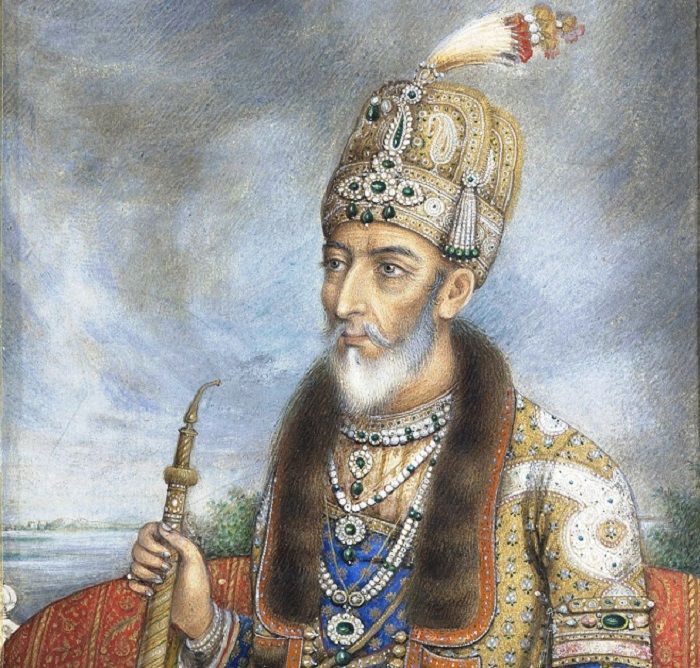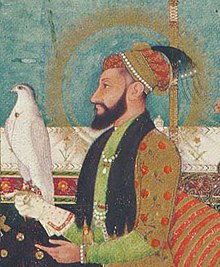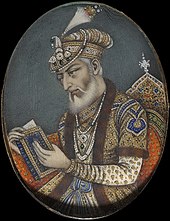
Aurangzeb was the sixth Mughal Emperor (1658-1707) during the golden period of the Mughal Empire. He was born as a Sunni-Hanafi Muslim who practiced Islam with great austerity, abstemiousness and piety throughout his life, praying with regularity, abstaining from drink and opium, memorizing the Quran, and sewing prayer caps in his older days. In spite of these qualities, among nationalists, he is the most controversial, orthodox, and conservative Mughal Emperor, who is blamed for murdering his brothers, demolishing pious temples, being a cultural dolt, etc., and eventually forcefully imposing Sharia (Islamic law) over the non-Muslim population. However, revisionist historians argue that the perception of Aurangzeb as an orthodox, cruel Muslim ruler can be traced through the War of Succession, in which he murdered his three brothers, especially Dara Sukoh, who was considered secular. Nationalist historian Jadunath Sarkar considered the War of Succession (1658) as a manifestation of the direct conflict between Dara’s syncretism and Aurangzeb’s orthodoxy that sealed the fate of Mughal decline. During the war of succession, Dara Sukoh portrayed himself as a liberal, secular, and mystic person to whom Vedantic Hinduism and Islam are both parts of the same divine scheme echoed in Sir-i-Akbari (1657). On the other hand, Aurangzeb, who had a good militaristic career prior to this, considered himself a true Sunni, a practicing Muslim, and the protector of Islam against Dara’s scholarly views. According to Munis Farooqi, princely succession struggles eventually revitalized Mughal power and prestige. Hence, rather than an ideological struggle, it should be seen as a struggle for power.

Aurangzeb’s religious policies and ideologies are summarized by the prohibition of music and other dance forms, the imposition of Jizya, which fueled the Rajput rebellion, and the destruction of temples. The primary sources for the banning of music in the reign of Aurangabad are the travelogs of Manucci and court historian, Kafi Khan. According to nationalist historians, musical instruments were banned and buried as a result of Aurangzeb’s Islamic orthodoxy. However, recent historians like Audrey Trushkey and Katherine Butler have declared it mythical. According to Katherine B. Brown, historians did not read the sources critically and saw music as a form of freedom, which was eventually prohibited under Aurangzeb’s bigoted ideology. Katherine Butler has argued that banning music by Aurangzeb should be considered personal denial, to fulfill his personal piety and religious consciences, but this was not averse to public and imperial musical practices, as only qawwals and kalawants were performed in his presence. To assert his power, Aurangzeb again donned his disguise by emphasizing Islam. This culminated in the reimposition of the jizya in 1679 on the grounds that it was wajib (compulsory) under shari’a. According to nationalist speculation, the imposition of Jaziya, a mandatory tax on the non-Muslim population, in 1679 was one of the main reasons for the Rajput rebellion against Mughal sovereignty. In contemporary Indo-Persian sources, Saqi Mustaf Khan and Iswardass mentioned that there was pressure from the Ulemas to impose Jizya, as it was mandatory in Sharia to impose Jizya on non-Muslims. European traveler Manucci considered that due to the financial crisis and ideological reasons, Jizya was reimposed by Aurangzeb.
Scholar Satish Chandra has challenged these arguments and perspectives, stating that if the imposition of Jizya was related to Islamic orthodoxy, where it was used as a tool to force non-Muslims to convert to Islam, then why did Aurangzeb take 22 years (1679) to implement this rule on non-Muslims? To counter the second reason, the decision to impose Jizya was motivated by a financial crisis. Satish Chandra has argued that in the 13th regnal year (1671), there was a financial crisis in the treasury of the Mughal Empire or a huge deficit in terms of Jama and Hasil, and simultaneously lots of wars were in progress. It was estimated in documents pertaining to the Badshahpur pargana that only 4% of the jizya was collected in rural regions, and in urban regions, it was 72%. Even though it wasn’t insignificant in urban areas, the money was stored in a different treasury called the Khazana-i-Jizya, which was primarily intended for charitable reasons and didn’t contribute to the Mughal empire’s revenue. Aurangzeb believed that implementing these policies was the best way to prevent difficulties and considered that his attempts to align his kingdom with sharia were attempts to legitimize himself because his Islamic policies had no bearing on state law. This legitimization dates back to the time he usurped the throne, and ever since, the ulama have opposed it. Hence, Jizya became a medium to impress Ulemas, and only they benefited from this.
When Aurangzeb was enthroned, there was a cordial relationship with the Rajputs of Amber, Mewar, and Marwar. However, some tension was created after the death of Jaswant Singh in terms of the internal politics of Marwar, as there was no legitimate heir for Gaddi of Marwar, hence the precedent to convert his territory to Khalisa land. According to historian R. Hallissey, the Rajput rebellion against the Mughals was between an imperialist empire and a regionalized traditional political structure. Hallissey also explores jizyah and refutes the idea that the Rajput insurrection was a mass movement by highlighting the cordial relations that many Rajputs had with the Mughals. It should be acknowledged that both the Rajput-Mughal conflict and the imposition of Jizya in 1679 were just coincidences.

Aurangzeb’s temple destruction policy has been heavily criticized and scrutinized. By translating Saqi Mustad Khan’s Maasir-i-Alamgir, Jadunaath Sarkar demonstrated that Aurangzeb was intolerant and vengeful against temple worship. In 1659, Aurangzeb declared that under Sharia, ancient temples should not be torn down and new temples should not be built. Historian Richard Eaton was constrained only to Banaras, and there were several pieces of evidence to provide madad-i-maash for the construction of temples. Audrey Truschke has pointed out that Aurangzeb considered himself an Indian king, a Mughal king, and a just king in his own vision, and he was engaged and obsessed with implementing justice (adal), which was the foremost duty of a king. Professor Truschke has mentioned that even Manucci, who was not an Aurangzeb enthusiast, wrote that, with melancholic temperaments, Aurangzeb was always busy executing justice and making appropriate decisions. Ishwardas, writing in Sanskrit, called Aurangzeb dharmya (righteous) and his taxes vidhivat (lawful). Aurangzeb was considered just in his ruling strategy by people of all religions and ethnic backgrounds. Aurangzeb’s notion of justice included some freedom of religious practice, and all the religious institutions were entitled to the protection of Mughal power. ¹² According to Barbara Medcalf, Aurangzeb constructed and patronized more temples than he destroyed. Andrew Truschke has described all these under the twinned policy of temple protection and temple destruction. She has pointed out that Hindu and Jain temples dot the landscape of the Mughal kingdom. In 1667, he confirmed the land grant and right to collect revenue from the Umanand temple at Guwahati, in Assam. In 1680, he declared that Bhagwant Gosain, a Hindu ascetic who lived on the banks of the Ganges in Benares, should be free from harassment. In 1687, he gave empty land on Benares Ghat to Ramjivan Gosain to build houses for “pious Brahmins and holy Faqirs.” In 1691, he conferred eight villages and tax-free land on Mahant Balak Das Nirvani of Chitrakoot to support the Balaji temple. As a result of Aurangabad’s default policy of protecting Hindu and Jain temples, most but not all temples still stood at the end of Aurangzeb’s reign. Aurangzeb considered that great monarchs are the reflections of God; they have a responsibility to make sure that people of all demeanors can live in harmony and prosperity. Nationalists considered that 60,000 temples were being destroyed under Aurangzeb’s Farman. However, historians are unable to trace the exact number of destroyed temples. Richard Eaton, who is the leading authority on this particular subject, considered that the destroyed temples were just a dozen, with fewer tied to the emperor’s direct order. Audrey Truschke considered the destroyed temples to be 15, not 12. The Benar Vishwanath temple was demolished in 1669; it was constructed during Akbar’s reign by Raja Man Singh, whose great-grandson Jain Singh was considered or blamed for escaping Shivaji from the Mughal court in 1666 and 1669, when affiliated Banaras landlords rebelled who were more connected to Benaras Vishwanath. Audrey has also mentioned that in 1669, Aurangzeb got to know that in Thatta, Multan, and especially Benaras, deviant Brahmins were teaching false books at their established schools and imparting wrong knowledge to their disciples. Eaton has argued that rulers’ legitimacy was derived from temples. As a result, claiming that Aurangzeb ordered the demolition of temples and the construction of mosques is historically inaccurate. It was entirely a political decision to punish the threat to sovereignty. As a result, it could be argued that in this case, Aurangzeb attempted to establish himself as a just ruler by not blindly adhering to the Sharia laws while also adhering to Islam as a religion with great piety. There were several political threats and conflicts that he faced throughout his regime, and the actions he took should be seen as those of a ruler who tried to protect his sovereignty in a legitimate way rather than connecting all of these with his religious practices.
Aurangzeb, according to Muzaffar Alam, was primarily a sharia-observant man and a fiq-law oriented Muslim. In Truschke’s words, Aurangzeb is best understood as a pre-modern Indian Emperor who pursued several ideals, including raw power, a vision of Mughal kingship, piety, and his particular perception of justice.

Swaliha Malik
Swaliha Malik is a History undergraduate at Miranda House who is curious to Religion and Modern History. Apart from being a history buff, she is a feminist who sees the world and societal norms through critical lenses. In her free time she binge watches, read, research and drinks coffee.

